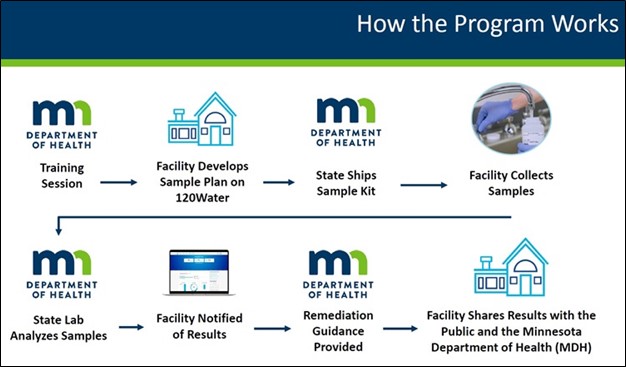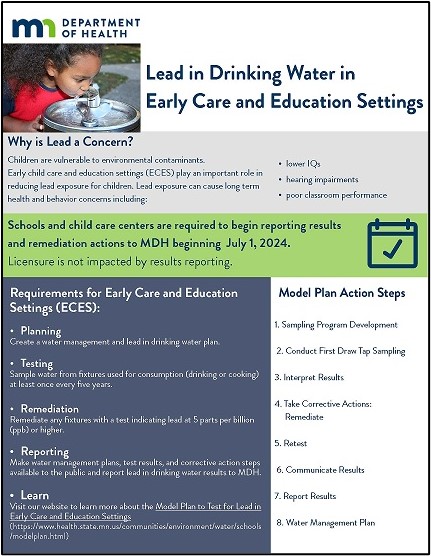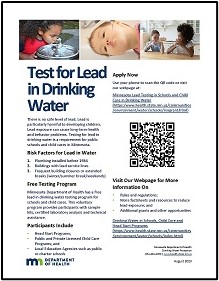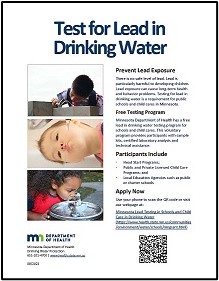Drinking Water Protection
- Drinking Water Protection Home
- About Us
- A-Z Index of Contaminants in Water
- Community Public Water Supply
- Drinking Water Grants and Loans
- Drinking Water Institute
- Drinking Water in Schools and Child Cares
- Drinking Water Revolving Fund
- Laws and Rules
- Noncommunity Public Water Supply
- Source Water Protection
- Water Operator and Certification Training
- Drinking Water Protection Contacts
Related Topics
- Annual Reports
- Drinking Water Risk Communication Toolkit
- Drinking Water Protection External Resources
- Fact Sheets
- Forms
- Invisible Heroes Videos: Minnesota's Drinking Water Providers
- Noncom Notes Newsletter
- Sample Collection Procedures (videos, pictures, written instructions)
- Waterline Newsletter
Related Sites
- 10 States Standards
- Clean Water Fund
- Health Risk Assessment – Guidance Values and Standards for Water
- Minnesota Well Index
- Water and Health
- Wells and Borings
Environmental Health Division
Minnesota Lead in Drinking Water Testing for Schools and Child Cares
Water Infrastructure Improvements for the Nation (WIIN) Grant Program
In 2019, MDH received a federal Water Infrastructure Improvements for the Nation (WIIN) grant from the Environmental Protection Agency to develop a voluntary lead in drinking water testing program for public schools, charter schools, licensed child care providers, and Head Start programs. This program is designed to provide free sample kits and laboratory analysis for lead in drinking water. MDH also provides assistance with interpreting and communicating results. MDH is not able to provide funds for remediation activities through this grant.
Download Flyers: Test for Lead in Drinking Water
Who is eligible to apply:
- Head Start Programs.
- Licensed Child Care Programs (both public and private).
- Local Education Agency such as public or charter schools.
- a Local Education Agency (as defined in section 8101 of Elementary and Secondary Education Act of 1965 [20 U.S.C. 7801])
MDH may prioritize sampling at facilities to target those most at risk such as:
- Schools and child care programs in underserved and/or low-income communities (e.g., schools with at least 50% of the children receiving free and reduced lunch or Head Start facilities);
- Facilities that primarily care for children 6 years and under; and
- Older facilities that are more likely to contain lead plumbing, built before 1986.
Participants must:
- Complete the application form.
Apply for enrollment by completing Minnesota Lead in Schools and Child Cares Testing Program Application form. - After the application for enrollment, the facility staff responsible for conducting the sampling must attend a virtual training session before sample kits are sent to the facility. MDH will contact the facility about upcoming training sessions.
- Complete sampling following the EPA: 3Ts for Reducing Lead in Drinking Water Toolkit or the MDH Model Plan for reducing lead.
- Notify staff, families, and MDH of the availability of the results.

(Visual image showing how the program works as explained above.)
Other resources
WIIN Grant: Lead Testing in School and Child Care Program Drinking Water | EPA
Lead in Drinking Water Training and Resources: For Early Care and Education Settings | MDH

Lead in Drinking Water
in Early Care and Education Settings (PDF)

